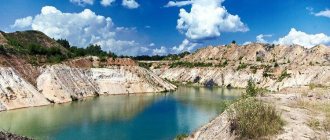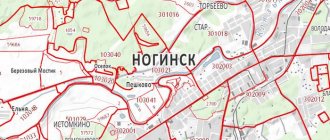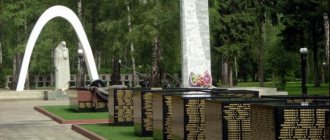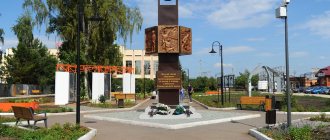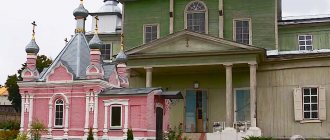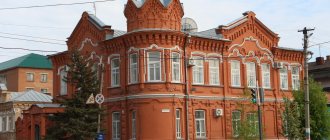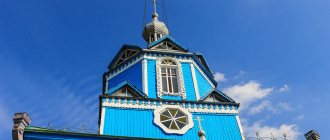On the banks of the Kolpna River, 25 kilometers from Tula, lies the small town of Shchekino. The very first settlement on the territory of the current city arose in 1870.
After the creation of the railway station at the beginning of the 20th century, the village was transformed into the Shchekinsky regional center, and in 1934 - into a workers’ village. After 4 years, the village was renamed a city, and in 1950 it received the status of urban regional subordination. And only in 2006 the modern city of Shchekino appeared, which became the center of the Shchekinsky district.
Today Shchekino is a large industrial center. There are very few attractions in the city itself; all the famous architectural monuments are located outside the city.
Monument "Tank on a pedestal"
The monument was erected in 1985 on Sovetskaya Street in honor of the 40th anniversary of the Great Victory to the soldiers of the Fiftieth Army and the Thirty-second Tank Brigade, who liberated the city of Shchekino from German troops in 1941. On the pedestal stands the famous tank from those battles, the IS-2 . IS stands for Joseph Stalin. Everyone who visited Belogorsk has a photograph with a tank.
Routes on the map of Shchekino. Transport infrastructure
The M-2 Moscow-Belgorod federal highway passes through Shchekino , thanks to which the city has transport links with the capital, as well as the Oryol, Kursk and Belgorod regions.
The railway connecting Moscow with Kharkov passes through Shchekino.
There is a bus station in Shchekino, through which the city communicates with other settlements of the Tula region, as well as Moscow, Orel, Ryazan, Kaluga.
Transportation within the city is carried out using minibuses.
Monument "Mourning Warrior with a Wreath"
It is a mass grave of Soviet soldiers. The area of the Monument – burial is 4500 square meters. m . It is fenced along the entire perimeter. Thus, we get a square, in the center of which stands the “Mourning Warrior with a Wreath.” There are 7 graves and 4 monuments with the names of fallen soldiers. It was installed in 1950.
Location: Lenin street.
Flag of Shchekinsky district
The flag of the Shchekinsky district is the official symbol of the municipal formation Shchekinsky district of the Tula region of the Russian Federation.
The flag was approved on June 24, 2009 by the decision of the Meeting of Representatives of the Shchekinsky District Municipal District No. 4/43 and entered into the State Heraldic Register of the Russian Federation under number 5014.
The flag is compiled on the basis of the coat of arms of the Shchekino region according to the rules and relevant traditions of heraldry and reflects historical, cultural, socio-economic, national and other local traditions.
Memorial ensemble to Shchekin soldiers
The memorial ensemble was erected in memory of the soldiers from the city of Shchekino who died in the Second World War. Every year, hundreds of people gather near this monument on May 9 to honor the memory of all those who died. Here the eternal flame never goes out, which seems to say that no one will ever be forgotten.
Location: Lenin street.
MAU Cultural Shchekino Museum of Art and Local Lore
It was opened in 1968. The exhibits were originally collected by enthusiasts of the city of Shchekino. Now the museum has 7,000 exhibits . By visiting it, you will get acquainted in more detail with the history of the Shchekinsky district. You will see how they dressed and lived their lives in the old days. The museum hosts exhibitions and other cultural events.
Location: Lenin street - 18/16.
Main streets of Shchekino
If you look at the map of Shchekino with streets, you can see that there are few major transport interchanges here. The main roads include the following streets:
- Sovetskaya is the central axis of the city. It passes through the entire Shchekino, entering it from the direction of Tula and exiting in the opposite direction. On this street are the Shchekinsky bus station, Central Park and the largest shopping center.
- Boldina is a street that also crosses the entire city. It enters the city along Sovetskaya Street, and at the exit from Shchekino it connects with the M-2 Crimea federal highway. In the immediate vicinity of Boldina Street there is a district hospital and a railway station.
- Lenina is a street that runs parallel to Sovetskaya. It runs through a residential area, connecting several central blocks. Lenin Street goes around Central Park on the opposite side of Sovetskaya Street.
- Pobeda is a street perpendicular to Sovetskaya. It originates on this central road and leads through residential areas to the village of Staraya Kolpna.
- Yuzhnaya is a street running along the southern border of the city. It connects Bolshie and Malye Ozerki and passes through the industrial district of Shchekino.
Monument to Igor Talkov
This is a very young monument, as it was installed on July 15, 2017, in honor of a native of the Tula region, Igor Talkov. He was a singer and composer, and he is revered because he madly loved the city of Shchekino and sang a song about it - “Small Town”, thereby glorifying it throughout the world. Talkov himself died at his concert and was buried in Moscow.
Location: Pervomaiskoe village, Simferopolskaya street - 19.
Shchekino on the map of Russia: nature, geographical location and climate
If you look at a map of Shchekino from a satellite, you can see that the city has an advantageous geographical location - in the central part of the region. The terrain here is mostly forest-steppe and flat with a large number of gullies and hollows.
The climate in Shchekino is continental-temperate. During the year, the average rainfall here is about 430-530 mm. The average air temperature for the year is 3.5-4.4 degrees above zero. The coldest months are January and February, the hottest are July and August.
and Kamushki rivers flow into Shchekino . There are several lakes and springs, the Shchekinskoye Reservoir .
The city is dominated by chernozem soils, which allows residents to actively develop agriculture.
The most common mineral resources in Shchekino are clay, sand and limestone.
Temple "Joy of All Who Sorrow"
The temple was founded in 1993 on Lev Tolstoy Street, 26. The whole world built the temple. Many people helped - from the weak to the sick and suffering. Sometimes there were not enough materials. At such moments, Father Nikolai (the rector of the temple) turned to the Most Holy Theotokos, and she provided help. There is an Orthodox school at the temple.
Monument "MIG-17"
Located next to the Pioneer House. Once upon a time there was a club for “Young Pilots and Cosmonauts”, where they taught flight skills. It was installed in the 80s. Previously, in addition to the MIG-17, there were also L-29 (with working equipment), Yak-52 (without wings), and Su-7B and Mi-4 were located behind the club. Only one MIG-17 has survived to this day.
Economy and industry Shchekino
Shchekino is the leader of the Tula region, not counting Tula itself, in terms of the number of enterprises located in it. This:
- The largest of them is Shchekinoazot OJSC, which produces chemical products used in industry, plastic, synthetic threads, and detergents for the population.
- Another important enterprise for the region is Khimvolokno OJSC, which produces synthetic threads and cord fabrics for various branches of domestic industry.
- , engaged in the repair of technical equipment and the production of spare parts for gas pumping units.
Also successfully operating in Shchekino are TMiK and refractory, OJSC Keramika, Shakhtspetsstroy, a bakery, a dairy plant, a pasta and confectionery plant and other enterprises. On the map of Shchekino with houses you can easily find the location of each of them.
Yasnaya Polyana Museum-Reserve
Everyone knows the outstanding Russian writer Lev Nikolaevich Tolstoy. He was born, raised and buried in Yasnaya Polyana. This estate, and especially the way of life and way of life that were inherent in it, left their indelible imprint on his work.
In the house of the famous writer to this day, museum curators preserve the furnishings of the last days of his life. There, as many years ago, his books, utensils, things, and paintings hang. His favorite table has been preserved, at which he wrote more than one masterpiece. There is a bench on which he liked to sit and think after long walks along the countless alleys of Yasnaya Polyana. In addition, you can pay tribute to the memory of L.N. Tolstoy by visiting the writer’s grave. It is located in the Old Sunset Forest. It's close to home. The grave is very modest - a small mound, and grass grows on it. However, everything was as he wanted.
At the estate, you can not only plunge into the times of Tolstoy’s life, get acquainted with his life and habits, but you can also ride horses around the outskirts of Yasnaya Polyana. The equestrian club, located on the estate, provides a wide range of services - horseback riding, in a carriage or on a sleigh (in winter).
The Yasnaya Polyana Museum-Reserve is located 8 km from the city of Shchekino, and you can get there in 15 minutes.
Exhibition of heraldry of the Tula region in the Shchekino Museum
An unusual mini-exhibition appeared in one of the windows of the Shchekino Museum of Local Lore on the eve of the national holiday of Russia Day. Any passerby can get acquainted with the heraldry of the Tula province of the century before last. The exhibition presents the Coats of Arms of all major cities, which were also the centers of the counties of the same name.
Heraldmaster Shcherbatov (his name, alas, has not survived) compiled their images, which were approved on March 8, 1778. By the way, the coats of arms of Tula, Aleksin, Belev and Cherny already existed earlier.
| Everyone knows the regional coat of arms. |
| Aleksin. “In a scarlet field are two golden clubs of Hercules, placed crosswise, with their thick ends up.” |
| Belev. “In a blue field stood a sheaf of barley, from which came a flame.” By the way, the coat of arms of the merchant town of Belev was created by Francis Santi at the beginning of the 18th century on the basis of information sent from the provincial chancellery. The report reported about a large fire that occurred shortly before sending information about the city; the fire destroyed “many households of Posatsk people”, and also “the entire log castle burned down.” |
| Bogoroditsk. “In the silver field are scattered nine branches of grass called the Mother of God, to indicate the name of this city.” |
| Venev. “Eight perpendicular stripes of green, intertwined with silver, and silver extending through one half of the shield, and the other half are the same stripes, but in the opposite position to the upper ones; in the middle is a golden measure of grain, representing the grain trade of this city.” |
| Epifan attracts special attention due to the presence in the coat of arms of the currently persecuted herb - hemp. “A shield, a silver field with black soil below, from which three hemp epics grow, showing that the circumference of this city abounds in hemp.” |
| Efremov. In a green field there are three silver plow coulters, showing the practice of the people of this country in agriculture.” |
| Nettle. “In the golden field, placed as a star, are six nettle branches named after this city.” |
| Odoev. “Since this city belonged to the Chernigov regions, then the very coat of arms of Chernigov belongs to it, as the inheritance of the then eldest tribe of these princes, that is, in a scarlet field, a black single-headed eagle holding in its right claws a golden cross, diagonally placed, with a difference in position from the Chernigov coat of arms at the top of the golden title." |
| Chekalin (Likhvin). “It was the Tatar custom to give evil-signifying names to those cities that strongly defended themselves against them and caused them significant harm, from which the name of this city came from, so: in a scarlet field, signifying bloodshed, its coat of arms is indicated: a standing ermine lion with a golden tongue and claws facing right; in his right paw he holds a brandished golden sword, and in his left a silver shield with a black cross, showing the nobility and courage of its inhabitants at that time and that “this defense was unfortunate for them.” |
| Black. “In a silver field flows the Black River, this color proves its depth, and on both sides there is a green sheaf of grass.” Much more modern are the coats of arms of the two largest cities in our region after Tula. |
| Novomoskovsk. Approved on March 24, 1999. “In the scarlet above there is a golden hammer on top of two silver picks crosswise, below there are golden amphorae lying on three green hills, indirectly overturned towards each other, from which silver streams flow crosswise. The shield may be surrounded by a ribbon of the Order of the Red Banner of Labor.” The two jugs on the coat of arms of Novomoskovsk symbolize the sources of the Don River. |
| Shchekino. The coat of arms of the city of Shchekino and the Shchekino region was approved on March 3, 2004 by a decision of the Duma of the city and region and entered into the State Heraldic Register. Authors of the coat of arms: O. Kwaktun, Y. Timonichev, A. Sobolev, K. Mochenov, Y. Korzhik, G. Tunik. In a scarlet field, under a golden head, burdened with three green nettle stalks extending upward in a fan-shaped manner, there are two golden hammers in a pillar, with the second hammer overturned and turned; on the sides the hammers are accompanied by silver pavilions with green rounded roofs and decorated with gold.” |
| Coat of arms of the urban settlement of Shchekino . Approved at the Meeting of Deputies on April 24, 2008. The coat of arms was designed by the Ryazan artist M.K. Shelkovenko. “In a scarlet (red) field there are two silver picks crosswise with their tips apart, threaded into the eye of a key of the same metal, placed with the beard down and to the right. The coat of arms is crowned with a municipal crown of the established pattern.” The scarlet field of the coat of arms corresponds to the territorial color of the Tula region and symbolizes bravery, courage, fearlessness, and hard work. Silver picks symbolize the mining industry, thanks to which the city of Shchekino arose and developed. The silver key means the keys to the bowels of the earth; its ear has the shape of a through heraldic stone, which also hints at the developed mining industry; and the beard, in its shape, resembles the letter Ш, which hints at the name of the city. The golden municipal crown with three visible teeth denotes the status of the city of Shchekino as a municipal entity “urban settlement”. |
Prepared by Elena KORNILKOVA
Article topics: Museums, Recreation
Kochakovsky necropolis
Kochakovsky necropolis or, as it is also called, the cemetery of the village of Kochaki. In the very center of the necropolis there is a temple built in the 17th century in the name of St. Nicholas the Wonderworker. The Tolstoy family is buried in this cemetery. It is this fact that makes this necropolis so famous. The family tomb contains the remains of Lev Nikolaevich’s parents - Maria Nikolaevna, Nikolai Ilyich and brother Dmitry Nikolaevich Tolstoy.
Not far from it you will find the grave of the writer’s grandfather, S.N. Volkonsky. A. S. Pirogova, who threw herself under a passing train because of an unsuccessful romance, is also buried there. This story impressed the writer so much that this tragedy was reflected in his famous novel, Anna Karenina.
The Kochakovsky necropolis is located 10.5 km from the city of Shchekino, you can get there by direct bus Shchekino-Kochaki.
Church of St. Nicholas the Wonderworker in the village of Kochaki
This temple has an interesting history of its formation. As old-timers say, the icon of Nicholas appeared on one of the bumps along the road leading to Kyiv. People passing by took her away. However, a few days later she appeared at the old place. This phenomenon was considered a sign and a temple was erected, which was called “Nicholas on a hummock.” The nearby area was nicknamed “Kochaki”.
Initially, the temple was a single altar church, but later it became a throne church, as two chapels were added. One - in the name of the holy martyr John the Warrior, and the second - in the name of Alexander Nevsky. With the money of patrons, a parish school and a house for priests were built in the church. But then Soviet power came, and the temple was desecrated, the icons were broken. A workshop for making and repairing wheels arose on the site of the church. And only in 1946 the abandoned temple and the adjacent territory were returned to the Orthodox Church. The Church of St. Nicholas the Wonderworker in the village of Kochaki is located next to the necropolis.
Kozlova Zaseka railway station
The history of this railway station is connected with the name of L.N. Tolstoy. Formed in 1868, it was the closest to the estate in which the writer lived. In those days, telephones were rare and were located only in places of special importance, which included stations, so Lev Nikolaevich often went there to make calls. Here the writer's friends and colleagues were met, his mail was sent and received, and even the coffin with the body of the great prose writer was delivered to this station in 1910.
The Kozlova Zaseka station was rebuilt more than once, but in 2001 it was decided to restore it and restore its original appearance. At the moment this is a functioning station, but it looks like it did during the writer’s lifetime.
You can get there by direct flight from Shchekino railway station and get off at Skuratovo Kozlova Zaseka station. The journey will take you 10-15 minutes. If you go by car, the distance from the city center is 12 km.
Shchekino and Shchekinsky district - Shchekino, Shchekinsky district, Tula region
The Shchekinsky district is part of the Central zone of the Tula region and, due to natural conditions, occupies an intermediate position between the regions of the Northwestern and Southeastern zones of the region.
Economic-social-geographical overview
The Shchekinsky district is part of the Central zone of the Tula region and, due to natural conditions, occupies an intermediate position between the regions of the Northwestern and Southeastern zones of the region.
The city of Shchekino is located 20 km south of the regional center of Tula, on the Moscow-Kharkov and Moscow-Simferopol railway and highways, which ensures its transport links with the most important industrial regions of the country.
The territory of the Shchekinsky district is 1378.86 square meters. km., incl. Shchekino - 32.52 sq. km. The terrain of the area is flat, heavily dissected by gullies and hollows.
The predominant soil type is podzol, highly leached and leached chernozems, which occupy 57.1% of all farmland, 22.9% of the land is light gray, gray and dark gray forest soils. The climate of the region changes from relatively temperate to continental. The average annual precipitation ranges from 430 to 530 mm. The average annual air temperature is from +3.50 to +4.40.
Among the common minerals, sand and clay predominate. The Shchekinsky district was formed in 1924 on the basis of the former Krapivensky district, and on November 27, 1938, the working village of Shchekino was transformed into a city of regional subordination by Decree of the Presidium of the Supreme Soviet of the RSFSR. The city of Shchekino grew up on the site of small mining villages. In 1950, Shchekino was transformed into a city of regional subordination and became a major industrial center. Currently, the mining area has turned into an area of chemistry and energy, mechanical engineering and highly developed agriculture.
On the territory of the district there is 1 city of regional subordination - the city of Sovetsk, 4 urban-type settlements (Novaya Ogarevka, Lomintsevo, Kaznacheevka, Pervomaisky), 19 rural administrations, uniting 234 settlements.
Currently, the population of the Municipal Formation “city. Shchekino and Shchekinsky district” - 117.7 thousand people, incl. men - 53.8 thousand people, women - 63.9 thousand people. Of these, 75.5 thousand people live in the city of Shchekino. Population density - 85.4 people/sq. km. The working age population is 59.62 thousand people. The number of people employed in the economy is 52.68 thousand people. The unemployment rate as of January 1, 2002 was 0.8%. 499 people were recognized as unemployed.
Shchekinsky district is one of the most developed industrial areas of the region. There are 1,182 enterprises in the production and non-production spheres in the region. Agriculture is focused mainly on the production of grain, potatoes and livestock products. There are 249 small enterprises and 2,461 entrepreneurs without a legal entity operating in the district. Small businesses provide employment to 3,861 people, which is 7.3% of the total employed population.
Industry
The largest enterprise in the region, JSC Shchekinoazot, is the largest enterprise in the chemical industry in Russia. The company specializes in the production of caprolactam, methanol, methenamine, ammonium sulfate, as well as consumer goods - cleaning and detergents. Shchekinoazot products have won a worthy place in the Russian and international markets, which emphasizes the quality of the products, the pricing policy of the enterprise and the profitability of production.
JSC Khimvolokno is one of the leading producers of synthetic threads and cord fabric in central Russia. JSC Khimvolokno cooperates with more than 350 enterprises in the defense, oil, gas, chemical, textile, fishing and light industries of Russia, near and far abroad.
The Shchekino plant for the repair of technological equipment, a branch of DOJSC Gazenergoservice of OJSC Gazprom, is one of the most stable enterprises not only in the region, but also in the industry. The plant's product range includes more than 400 types of spare parts, components and equipment for stationary domestic and imported gas pumping units. The geography of supplies is extensive: Belarus, Kazakhstan, Ukraine, Uzbekistan, Iran, Jordan, Czech Republic. AOZT plant “Kislotoupor” is a large modern enterprise. The main products are ceramic pipes, acid-resistant materials (bricks, tiles, Raschig rings and facing (facade) tiles), as well as ceramic dishes, which are in great demand.
The TMiK plant, located in Sovetsk, produces mineral wool mats for insulating building structures of buildings and structures and industrial equipment, thermal insulation mats for thermal insulation of thermal power plant and nuclear power plant equipment and pipelines, etc. The products of Shchekinsky Refractory Plant OJSC are fireproof products, Common consumption goods.
The main activity of Keramika OJSC is the production and sale of ceramic bricks, building materials, industrial and technical products and consumer goods. The branch of the State Unitary Enterprise “Trest “Shakhtspetsstroy” - an experimental mechanical plant for mining equipment carries out work on the manufacture of mining and non-standardized equipment.
CJSC Shchekinsky Bread Factory, LLC Shchekinsky Pasta and Confectionery Plant, JSC Shchekinsky Dairy Plant produce high-quality bakery, confectionery and dairy products in a wide range, which are in great demand among the population.
Shchekinsky district is a region with powerful development potential. The main direction of activity in the region is the targeted improvement of technological processes, reliability and efficiency of production, and the development of the production of new competitive products.
Healthcare
There are 18 institutions in the healthcare system of the city of Shchekino and the Shchekinsky district. These are 6 city hospitals, 3 district hospitals, 3 outpatient clinics, a dental clinic, 2 dispensaries, an ambulance station, a hospice, 2 sanatoriums (for tuberculosis patients and for visually impaired children). Outpatient medical care in the region is provided by 14 clinics and 3 outpatient clinics with a total capacity of 2,135 visits per shift in 32 specialties. There are 4 general practitioners in the area.
Inpatient care is provided by 12 medical institutions with a total number of beds of 1,455 in 22 specialties.
In 1991, the second hospice in Russia with 30 beds for cancer patients was opened. The Soviet City Hospital has a gerontological department with 45 beds.
There are specialized departments in the region that treat patients not only in Shchekinsky, but also in nearby areas: these are traumatology, ophthalmology, neurology, urology, maternity departments, and the department of the second stage of nursing premature babies.
Culture
Shchekino and Shchekinsky district are operated by 91 cultural institutions: 2 city Palaces of Culture, 28 township and rural Houses of Culture, 7 rural clubs, 1 leisure center and cinema-video service “Sokol”, 42 libraries, 1 art and local history museum, Lesnaya park Polyana", 4 children's music schools with 7 rural branches, 5 propaganda and cultural brigades are engaged in servicing remote rural settlements. 5 folk groups conduct active concert activities. On the territory of the Shchekinsky district there are 210 historical and cultural monuments, of which: 161 archaeological monuments, 28 architectural monuments, 21 historical monuments, including 17 mass graves. 6 archaeological monuments are objects of historical and cultural heritage of federal significance. In the protected areas of the Shchekinsky district of the Tula region there is a pearl of Russian culture - Yasnaya Polyana. The brilliant writer of the 19th and 20th centuries, Lev Nikolaevich Tolstoy, was born, lived and worked here. The museum complex includes the house-museum of L. N. Tolstoy, which preserves its original furnishings, an outbuilding (which housed a school for peasant children and the editorial office of the Yasnaya Polyana magazine), outbuildings, a park, and Tolstoy’s grave. The most famous works of Lev Nikolaevich, which became classics of Russian literature, were created here. Yasnaya Polyana, during the writer’s lifetime, became a kind of spiritual center of Russian and world culture.
Education
The education system of the Shchekinsky municipality is represented by 42 preschool educational institutions, 48 general education institutions of various types, 5 institutions of additional education for children, 2 evening (shift) secondary schools, 2 boarding schools, 2 interschool educational centers and an institution of additional education for adults “City Methodological Center”.
The implementation of various educational needs is facilitated by the structural restructuring of the network of educational institutions. There are new types of institutions operating in the area - 1 lyceum, 2 gymnasiums, primary school-kindergarten No. 22. In the 2000/2001 academic year, a “Health School” was created on the basis of secondary school No. 20, the purpose of which is to provide conditions for maintaining the health and development of children during the educational process.
In preschool educational institutions there are groups for children with musculoskeletal disorders, groups for round-the-clock attendance of children, and weekend groups. The Education Committee is working to introduce new forms of preschool education based on short-term stays for children. On the basis of secondary schools, specialized classes have been created, where communication with universities is carried out: TSPU named after. L.N. Tolstoy, TSU, Moscow Law Institute under the Ministry of Justice, Ryazan Medical Institute, Moscow Mining State University, Novomoskovsk Institute of Russian Chemical Technology named after. DI. Mendeleev. Profile training allows for continuity between secondary and higher education, contributes to career guidance and social protection of school graduates.
Youth policy and sports
Since 1999, work with youth has been headed by the Youth Policy Committee on the basis of the Federal Program “Youth of Russia”. The structure of the committee is Youth with a branch - a martial arts club. The center is a multidisciplinary institution that works with children and youth aged 5 to 30 years and provides professional consulting, psychological, social and informational assistance. Up to 600 people pass through the various departments of the Youth Center every week. The committee pays special attention to the problem of employment, as well as temporary employment of students. In the period from January 1 to December 1, 2001, 414 people applied to the Youth Labor Exchange. During the summer holidays, 132 people were employed. In 2001, 303 people were healed through various forms of recreation through the committee (Finland, All-Russian Children's Center "Orlyonok", regional specialized camps, city labor camp). As part of supporting talented youth, a competition of documents for a scholarship from the committee is held annually. In 2001, based on the results of the competition, 17 young people and teenagers were paid a committee scholarship.
Author: Head of the municipality Ermakov Vladimir Gavrilovich Source: Domolink network, user Nastenka.
Village Krapivna
This completely inconspicuous village has a great history. It is believed that the initial mention of the village of Krapivna took place in 1389, when the will of Dmitry Donskoy was read out. The village was originally part of the Moscow province. And after some time it became the center of the Tula province. It was destroyed during the Crimean Tatar invasion of Tula under the leadership of Khan Devlet I Giray. Krapivna was one of the temporary places of residence of False Dmitry I. This is only a small but significant part of the events that befell the village.
Today you can visit the Trinity Church, St. Nicholas Cathedral and the All Saints Cemetery Church. Residents hold the Nettle Festival every year. It took place for the first time in 2002.
The village of Krapivna is located 33 km from the city of Shchekino, which is approximately 35-45 minutes depending on road congestion
Arboretum at the Krapivensky Forestry Technical School
The Arboretum is a natural monument. Now 540 species of various plants . This is a beautiful place with unusual plants brought from different parts of the globe.
It is believed that the park was originally founded on a 2-hectare site in 1929. Today it occupies 7 hectares. The old part of the park, although it includes many non-European plant species, is still a department of the dendroflora of Europe.
The arboretum at the Krapivensky Forestry Technical School is located in the village of Selivanovo, 26 km from the city of Shchekino (35-40 min)
Only a small, but most significant part of the sights of Shchekino was presented to your attention. If you do not visit these places, then we can say that you have not been to Shchekino.
Shchekino - a city of workers' glory
Peter the First, Catherine the Second, Alexander the First, Nicholas the First, Joseph Stalin, Nikita Khrushchev, Leonid Brezhnev, Yuri Andropov, Boris Yeltsin, Vladimir Putin visited the territory of the modern Shchekinsky district at different times. How many Russian cities can boast of such a fact!
Five million pounds of cargo
At the end of the nineteenth century, in these places there was a railway station Yasenki and the village of Kolpna. In 1870, the village of Shchekino arose near the Yasenki station. In 1904, it merged with the station village of Yasenki under the general name of the Shchekino village.
The settlement in these places began to grow due to the development of brown coal deposits. The first mine was laid by the English concessionaires Gill brothers in 1870, opening four mines named after the daughters of one of the brothers: “Barbara”, “Emily”, “Magdalene”, “Mary”. The most powerful one, named “Pavel,” produced only two carloads of coal per day. At the same time, the Gill brothers built two small factories – one for refractory bricks and one for the production of sulfuric and nitric acids.
Already from the beginning of the twentieth century, Shchekino began to turn into a major economic center of the Tula province. So, according to statistics, the Shchekino station was in second place after the Tula-Kurskaya station in sending goods, ahead of even Efremov and the Tula S.-V. station. railway. About five million poods of goods were sent from Shchekino. This activity was associated with the flourishing of the coal mining industry.
The outskirts of Shchekino also became one of the centers of dacha summer holidays, which were gaining popularity at that time. With the opening of the summer season, all trains going to Shchekino were overcrowded with passengers to the last degree. In Shchekino itself there was only one attraction - the grave of the soldier Vasily Shibunin, whom Leo Tolstoy unsuccessfully tried to protect in 1866.
Shibunin was brought before a military court for the slap he gave to an officer. Tolstoy agreed to speak in his defense at the trial; he was confident of success. However, the court sentenced Shibunin to death. Tolstoy, in order to mitigate his sentence, tried to use his connections in high society, but to no avail. All these events became the basis for the film “The Story of a Destination,” filmed in 2022. The role of Vasily Shabunin was played by Philip Gurevich.
On August 9, 1866, a public execution was held in Novaya Kolpna. Many people gathered at the pole to which Shabunin was tied, women were crying and fainting. The body of the executed man was buried not far from the future Shchekino station. Within an hour, a priest came to the grave and served custom-made memorial services almost continuously. Candles, pieces of canvas and copper coins were thrown onto the grave. The same thing happened again the next day. The grave has become a local landmark. However, soon the bailiff ordered it to be razed to the ground and posted a guard with the order not to allow the curious. The service of memorial services was also prohibited. Subsequently, soldier Shabunin was reburied in a mass grave on Lev Tolstoy Street in Shchekino.
Shchekinsky method, ahead of its time
After 1917, active construction and reconstruction of old mines began. By 1941, eight of them were already operating and four more were under construction.
In 1924, the Krapivensky district was liquidated, and in its place the Shchekinsky district was formed with its center in the village of Kolpna, then the Shchekino station. Workers' settlements grew up around mines, mines and factories. The area near the Yasenki railway station was populated especially quickly. The village at Shchekino station grew and developed.
An important impetus for the development of the city was the decision to build it in 1929. Thanks to the miners and the new enterprise, the city began to be actively developed, and a small workers' settlement grew up.
In 1932, a brick factory, a dairy factory and a bakery appeared in Shchekino.
On July 1, 1934, the workers' settlement of Shchekino was formed. It includes the villages of Novaya Kolpna and Socialisthesky, settlements near a ceramic and acid-resistant plant and at the Shchekino railway station. And on November 27, 1938, it was transformed into the mining town of Shchekino. It was called the pearl of the Moscow region coal basin.
The coal industry has become the main industry in Shchekino. It provided over 60 percent of the city's gross output. For the first time in the Moscow basin, shield lava fastenings appeared here.
Each time has its own achievements. By January 1, 1941, 2,475 radio points were installed in the city. The villages of mines No. 9, 17, collective farm named after. VI Congress of Soviets. During the year, 4.5 km of new radio broadcast lines were laid, 10 km of lines were reconstructed.
During the war, the Shchekinsky district was occupied by the Germans and liberated on December 17, 1941 by troops of the Western Front during the Tula operation.
Since 2006, the city became part of the Shchekinsky district as a municipal formation (urban settlement) “city of Shchekino”.
Its modern city-forming enterprises are technologically and organizationally interconnected JSC Shchekinoazot (manufacturer of nitrogen fertilizers and petrochemical products) and JSC Khimvolokno (nylon threads and cord).
Shchekino is the birthplace of the famous Shchekino method, which in Soviet times thundered throughout the country.
“The principles of development of productive forces used in the Shchekino method remain relevant in the current period. In its content, the red line is the disclosure of the potential capabilities inherent in the human factor. The economic experiment in practice proved the need for dynamic development of production,” said its creator Pyotr Mikhailovich Sharov.
Famous Shchekinites
Rock musician, songwriter, composer Igor Talkov. He studied at school No. 11 in Shchekino, where he played in the school ensemble and directed the choir. In the eighties he was one of the most popular pop singers in the USSR.
On July 15, 2022, a monument to Igor Talkov was erected in the park of the Shchekino City Palace of Culture. School No. 11, where he studied, is also named after Talkov.
Cosmonaut Sergei Zaletin made his first space flight lasting 72 days 19 hours 42 minutes 16 seconds in 2000. He was the commander of the Soyuz TM-30 transport ship and the last commander of the Mir orbital complex, which was sunk in 2001. On May 12, 2000, he performed a spacewalk lasting 5 hours and 3 minutes.
By decree of the President of the Russian Federation, Lieutenant Colonel Zaletin received the title of Hero of the Russian Federation for the courage and heroism shown during the space flight at the Mir orbital research complex. In 2002, he made his second space flight lasting 10 days 20 hours 53 minutes 9 seconds. Secondary school No. 13 in Shchekino is named after Zaletin.
A native of Shchekino, Tatyana Ledovskaya in 1988 became the champion of the 1988 Olympic Games in Seoul in the 4x400 meter relay and won a silver medal in the 400 meter hurdles.
Football goalkeeper Valery Kleimenov played in Arsenal Tula, Russian major league clubs, including Rotor Volgograd and Dynamo Moscow, and in 1992 he played two matches for the CIS national team.
The famous polar explorer, Arctic explorer, geographer and meteorologist Boris Kremer in 1935 was one of the organizers of the second polar station “Cape Tin” on Severnaya Zemlya. In 1941-1943, he was the head of polar stations on Cape Arktichesky and on Domashny Island as part of the Severnaya Zemlya archipelago. The work of the polar station was necessary to provide meteorological reports to the army and navy. Many Soviet polar stations were destroyed by shelling, but the heroic polar explorers continued to keep watch. A container of food washed ashore was smashed on the rocks, and most of it was lost.
Boris Kremer's group spent the winter with virtually no food supplies. At the same time, weather reports were required every hour during daylight hours. As it turned out later, most often this was disinformation for the enemy, to create the illusion that Soviet aviation was in the air. The urn with the ashes of Boris Alexandrovich, according to the will, was buried on Domashny Island. Just like the literary discoverer of the Northern Land, Captain Tatarinov, Boris Kremer’s gravestone bears the motto: “Fight and search!”
Six Shchekin residents became Heroes of the Soviet Union during the Great Patriotic War.
